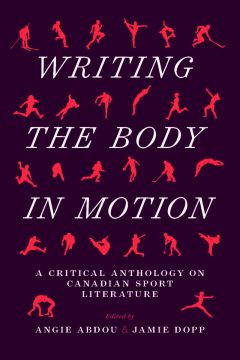The Humboldt Broncos catastrophe begs for treatment by a skillful Canadian poet. Prairie road, quiet night, the sickening rip of metal as a busload of clean-cut, small-town kids perished on their way to a playoff game. It inspired an extraordinary outpouring of national grief beyond any celebrity death. Yet there are few hockey poems in Canada, “no doubt related to the snobbery with which the Canadian cultural elite has treated hockey historically,” notes Writing The Body In Motion: A Critical Anthology On Canadian Sport Literature.
Editors Angie Abdou of Athabasca University and Jamie Dopp of the University of Victoria compiled this beautiful anthology on literature and sport. “Hockey, as a game, is a potential source of fun and play,” writes contributor Jason Blake. “That said, sport and play are not synonymous, nor does a game necessarily engender enjoyment (as anyone who has played Monopoly knows).”
Contributors recount a haunting story from poet Randall Maggs’ 2008 Sawchuk Poems that tells of the night legendary goaltender Terry Sawchuk was given a misconduct penalty for telling referee Red Storey to “go f—k yourself”; two days later, Sawchuk skated up to the ref at the Montreal Forum to ask why he was penalized.
“‘What was it for, you big Palooka?’ I say, ‘You told me to eff off. You can’t say that to a referee.’ What I really wanted to say was you can’t treat friends that way. He just stares at me a moment and you know how dark and scary his eyes could be, I don’t even know what he was feeling, sad or sorry or angry. ‘I don’t remember that,’ he says. ‘I don’t remember any of that.’”
Writing The Body offers a moving epilogue: “Over his twenty-one seasons in the NHL (1949-1970), in an era when few goalies had a career lasting more than a decade, Sawchuk recorded 447 wins and 103 shutouts, NHL records that stood for decades. The price his body had paid by the time of his early death at the age of forty included broken bones (including a poorly healed broken arm that wound up two inches shorter than the other), six hundred stitches, torn tendons, a devastating eye injury, ruptured discs in the spine, a swayed back from his famous crouch stance, and a nervous breakdown.”
The literary world typically treats sports heroes as caricatures or figures in a morality play, the “underdog-to-podium sport narrative”, says Writing The Body. They are so much more. Canadians pause at the mention of Marilyn Bell or Tom Longboat, Cyclone Taylor, Ernie Richardson or Etienne Desmarteau, the Montréal policeman who won the hammer throw at the 1904 St. Louis Olympics. “It’s about the stories we tell about ourselves, about who we are as a nation, and most importantly, about why we need these stories,” editors explain.
Writing the Body in Motion is wonderful Canadiana. From poet Richard Harrison’s 1991 Hockey Player Sonnets:
- “Lindros is afraid of breaking
- nothing. I saw him bust a man’s collarbone in Maple
- Leaf Gardens, and nearly break another man’s leg,
- score one goal and assist on another. The fans went
- wild, and it proves how little we have for ourselves:
- given the chance, I’d be him.”
By Holly Doan
Writing the Body in Motion: A Critical Anthology on Canadian Sport Literature, edited by Angie Abdou and Jamie Dopp; Athabasca University Press; 200 pages; ISBN 9781-7719-92282; $34.99






